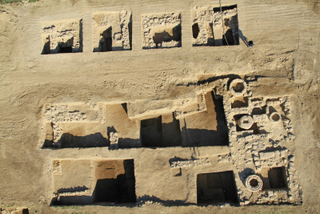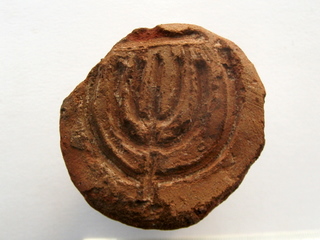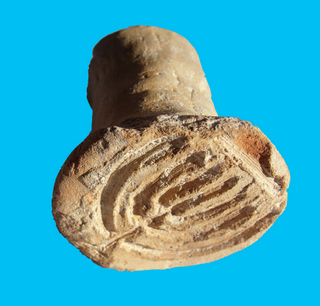Jewish Temple Menorah Found Illustrated on Ancient Bread Stamp
What do the Arabs and their friends who lately and fashionably have been denying the Jewish history of the Land of Israel [as per PLO charter, Article 20; see at bottom] have to say about that?
- - - - - - - - - - - - - - - - - - - - - - - - - - - - - - - -
A Stamp with the Temple Menorah was Uncovered in Excavations near Akko (January 2012)
| The tiny stamp was used to identify baked products and it probably belonged to a bakery that supplied kosher bread to the Jews of Akko in the Byzantine period | ||
A 1,500 year old seal bearing an image of the seven-branched Temple Menorah was discovered near the city of Akko. A ceramic stamp from the Byzantine period (6th century CE) was discovered in excavations the Israel Antiquities Authority is currently conducting at Horbat Uza east of Akko, prior to the construction of the Akko-Karmiel railroad track by the Israel National Roads Company. This find belongs to a group of stamps referred to as “bread stamps” because they were usually used to stamp baked goods. According to Gilad Jaffe and Dr. Danny Syon, the directors of the excavation on behalf of the Israel Antiquities Authority, “A number of stamps bearing an image of a menorah are known from different collections. The Temple Menorah, being a Jewish symbol par excellence, indicates the stamps belonged to Jews, unlike Christian bread stamps with the cross pattern which were much more common in the Byzantine period”. According to Syon, “This is the first time such a stamp is discovered in a controlled archaeological excavation, thus making it possible to determine its provenance and date of manufacture. The stamp is important because it proves that a Jewish community existed in the settlement of Uza in the Christian-Byzantine period. The presence of a Jewish settlement so close to Akko – a region that was definitely Christian at this time – constitutes an innovation in archaeological research”. The excavators add, “Due to the geographical proximity of Horbat Uza to Akko, we can speculate that the settlement supplied kosher baked goods to the Jews of Akko in the Byzantine period”. The stamp is engraved with a seven-branched menorah atop a narrow base, and the top of the branches forms a horizontal line. A number of Greek letters are engraved around a circle and dot on the end of the handle. Dr. Leah Di Segni, of the Hebrew University of Jerusalem suggested this is probably the name Launtius [see comment on name below]. This name was common among Jews of the period and also appears on another Jewish bread stamp of unknown provenance. According to Dr. Syon and Gilad Jaffe, “This is probably the name of the baker from Horbat Uza.” Horbat Uza is a small rural settlement where clues were previously found that allude to it being a Jewish settlement: a clay coffin, a Shabbat lamp and jars with menorah patterns painted on them were discovered there. Dr. David Amit of the Israel Antiquities Authority, who has made a study of bread stamps, adds, “A potter engraved the menorah image in the surface of the stamp prior to firing it in a kiln, whereas the owner’s name was engraved in the stamp’s handle after firing. Hence we can assume that a series of stamps bearing the menorah symbol were produced for Jewish bakers, and each of these bakers carved his name on the handle, which also served as a stamp. In this way the dough could be stamped twice before baking: once with the menorah – the general symbol of the Jewish identity of Jewish bakeries, and the private name of the baker in each of these bakeries, which also guaranteed the bakery’s kashrut. |
|
|
PLO charter, Article 20, denies the Jewish history of the Land of Israel, the country that the Romans called Judea [IVDAEA] in the heyday of the Roman Empire. The relevant sentence reads:
"Claims of historical or religious ties of Jews with Palestine are incompatible with the facts of history and the true conception of what constitutes statehood." [translation in: Walter Laqueur & Barry Rubin, eds., The Israel-Arab Reader (New York/London: Penguin 2008), p. 119]
Also see this recent post at Emet m'Tsiyon about another recent archeological finding.
Comment on the name on the knob. The announcement above published on the site of the Antiquities Authority may have been translated from Hebrew, which is usually written without vowels, as many readers know. Hence, the name spelled Launtius in the announcement may have been Leontios in Greek.
Labels: archeology, Great Revolt against Rome, Jerusalem, Jewish Temple





4 Comments:
Such a great article which The seven-branched menorah was a common Jewish symbol in the centuries after destruction of the Temple by Roman and auxiliary forces in 70 CE. A Greek-language inscription was found on the knob used to hold the stamp. This inscription seems to be the baker's name. He was advertising kosher quality of his product and his own bakery. Thanks for sharing this article.
By Pat, at 3:11 PM
Pat, at 3:11 PM
such a great article for inspiration of life if you more information how this type of thing keep life from spoil type of thing then link here גירושין
By joymo, at 11:13 AM
joymo, at 11:13 AM
This is really satisfied by the nice services in this blog that to really providing the wonderful info is visible in this blog
By pay per head, at 6:30 AM
pay per head, at 6:30 AM
another proove that the Jewish Menorah is ours and not the muslims like they claim.
By Unknown, at 10:44 AM
Unknown, at 10:44 AM
Post a Comment
<< Home